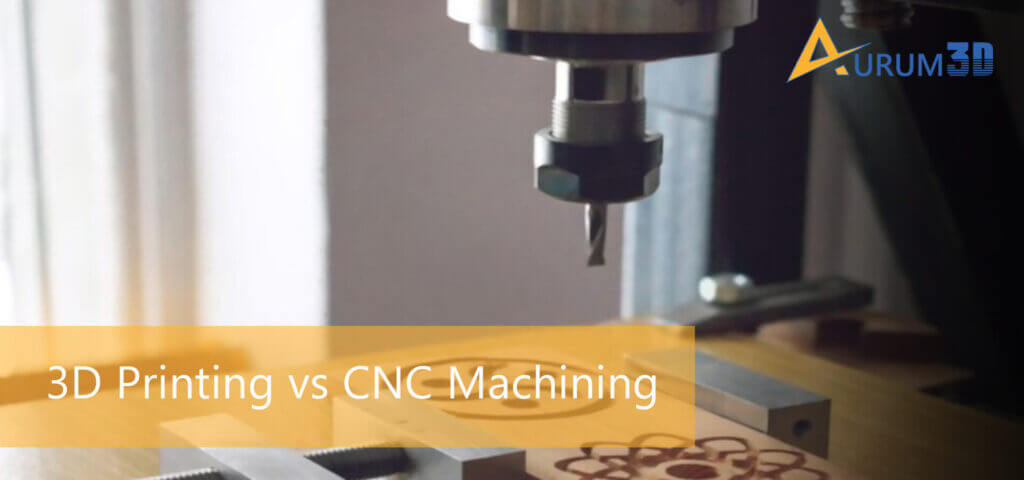While creating a fully-functional part or prototype, you have the option to choose from many manufacturing technologies. The manufacturing technologies and methods can be broadly divided into two categories – additive and subtractive. Additive manufacturing technologies create three-dimensional parts and prototype layer by layer from digital 3D models.
On the other hand, subtractive manufacturing technologies form solid three-dimensional objects by removing unnecessary materials from a solid block material successively. 3D printing is a widely-used additive manufacturing technology, while computer numerical control (CNC) machining is one of the most popular forms of subtractive manufacturing.
Hence, 3D printing and CNC machining differ from each other in several aspects. While comparing 3D printing vs CNC machining, you must keep in mind the key differences between additive manufacturing and subtractive manufacturing process. Also, you can choose the right option by distinguishing between various types of 3D printing and CNC machining.
3D Printing Technologies
As a form of additive manufacturing, 3D printing produces three-dimensional items physically from digital 3D models. 3D printing technologies create the solid form or structure by depositing materials layer by layer. Also, every 3D-printing technology deposits, fuses and solidifies filaments in a specific way.
According to Wikipedia,
“The term ‘3D printing’ can refer to a variety of processes in which material is deposited, joined or solidified under computer control to create a three-dimensional object, with the material being added together (such as plastics, liquids, or powder grains being fused together), typically layer by layer.”
You have the option to choose from many types of 3D printing technologies. Likewise, you can choose from a wide range of 3D printing materials. You must combine the right 3D printing technology and material to produce parts and prototypes according to your precise project needs. Also, you should adopt a slew of best practices to boost the quality of the 3D-printer object.
CNC Machining Technologies
As a form of subtractive manufacturing, CNC machining creates solid three-dimensional objects from hard materials using factory machinery and tools. CNC machining technologies dictate the movement of machines and tools using pre-programmed computer programs. The automated motion control machines remove unnecessary materials from the block quickly and accurately.
According to Factory.com,
“CNC machining is a metal fabrication method where written code controls the machinery in the manufacturing process. The code determines everything from the movement of the cutting head and the part to spindle speed, RPMs, etc.”
You can choose from many types of CNC machining according to your precise project needs. Each technology produces parts and prototypes using a specific fabrication technique. You must focus on the size and fabrication method to pick the right CNC machines for your project.
3D Printing vs CNC Machining
Materials
While using CNC machines, engineers have the option to use a variety of heavy materials – metal alloys, thermoplastics, machining wax, wood, and acrylic. Likewise, engineers can choose from several forms of plastic, resin, and powder materials while using 3D printers. 3D printing helps them to reduce material wastage. But engineers can choose from more materials while using CNC machines than 3D printers.
Prototyping Speed
3D printing beats CNC machining in the category of speed. Engineers can use 3D printers to produce multiple versions of a part or prototype in a short amount of time. Also, many 3D printing service providers deliver printed parts or prototypes in a few days. But CNC machining involves additional post-processing activities. The post-processing makes CNC machining slower to build than 3D printing.
Prototype Integrity
CNC machines do not heat or melt materials. Hence, the properties and structure of the material remain intact. Engineers opt for 3D machining to produce prototypes with enhanced strength and better structural integrity. Certain 3D printing technologies impact prototypes by heating and melting the materials. But new-generation 3D printing technologies protect prototype integrity by supporting composite filaments.
Build Quality
Engineers prefer CNC machining to 3D printing to boost the overall quality of the build. In addition to facilitating voluminous production, CNC machines are effective in producing large, durable, and dependable parts. On the other hand, engineers use 3D printers to produce parts with complex designs and intricate geometries. Specific 3D printing technologies enable engineers to enjoy the freedom of design.
Build Size
While using a 3D printer, you have to restrict the size of the part to the size of the printing bed. You need to use expensive industrial 3D printers to produce larger parts accurately. But you can use CNC machines to produce parts of varying sizes and shapes. Hence, engineers prefer CNC machining to 3D printing while producing large parts or prototypes.
Various Tools
While 3D-printing a part or prototype, engineers need not use multiple tools. They can print the part accurately using the right 3D printer and filament. But CNC machines create parts using various tools. The multiple tools make CNC machines more complex than 3D printers. Enterprises deploy trained professionals to operate various tools and machines accurately through pre-programming.
Post-Processing
Post-processing activities like sanding and grinding are an integral part of the CNC machining process. Engineers can deliver the part to clients only after performing required post-processing activities. The post-processing activities vary across 3D printing technologies. Items printed using specific 3D printers need additional post-processing than others.
Costs
3D printers produce parts and prototypes in a cost-efficient way. In addition to reducing material costs, specific 3D printing technologies facilitate material recycling. Also, enterprises in the automotive, aerospace, and manufacturing industries curtail overall costs by availing of professional 3D printing services. But CNC machining escalates the costs of production or prototyping due to post-processing activities.
Common Use Cases
Most enterprises these days opt for various 3D printing technologies to curtail prototyping or production costs. They combine the appropriate 3D printing technology and filament to complement the varying shapes and aesthetics of products. But many enterprises choose CNC machining for large-scale production. Also, CNC machining produces parts with high precision and superior surface quality.
Conclusion
3D printing is an additive manufacturing technology, while CNC machining is a form of subtractive manufacturing. You have the option to choose from different types of 3D printing and CNC machining. Each type of 3D printing and CNC machining has its pros and cons. Hence, you must keep in mind the pros and cons of individual technologies to compare 3D printing vs CNC machining accurately.

